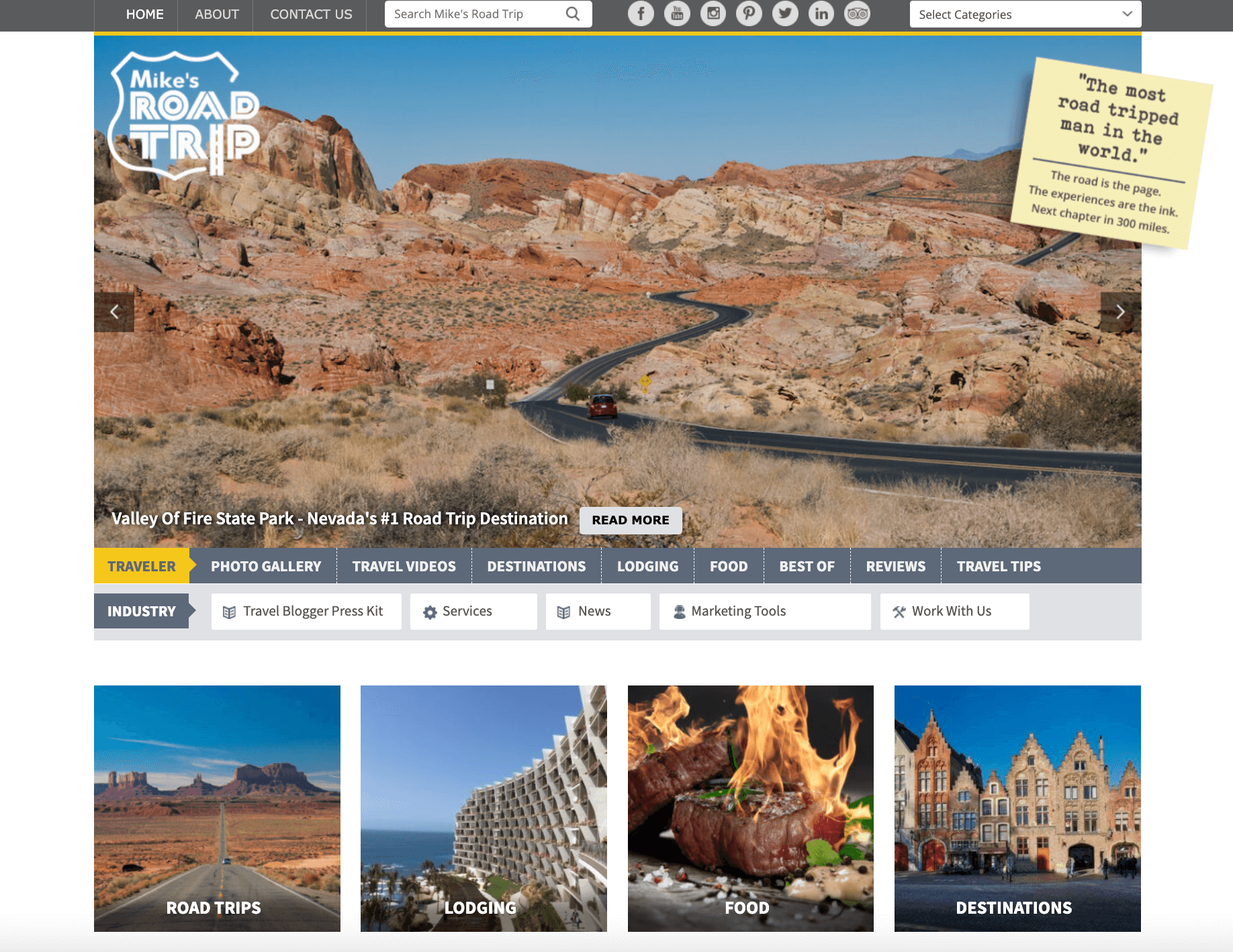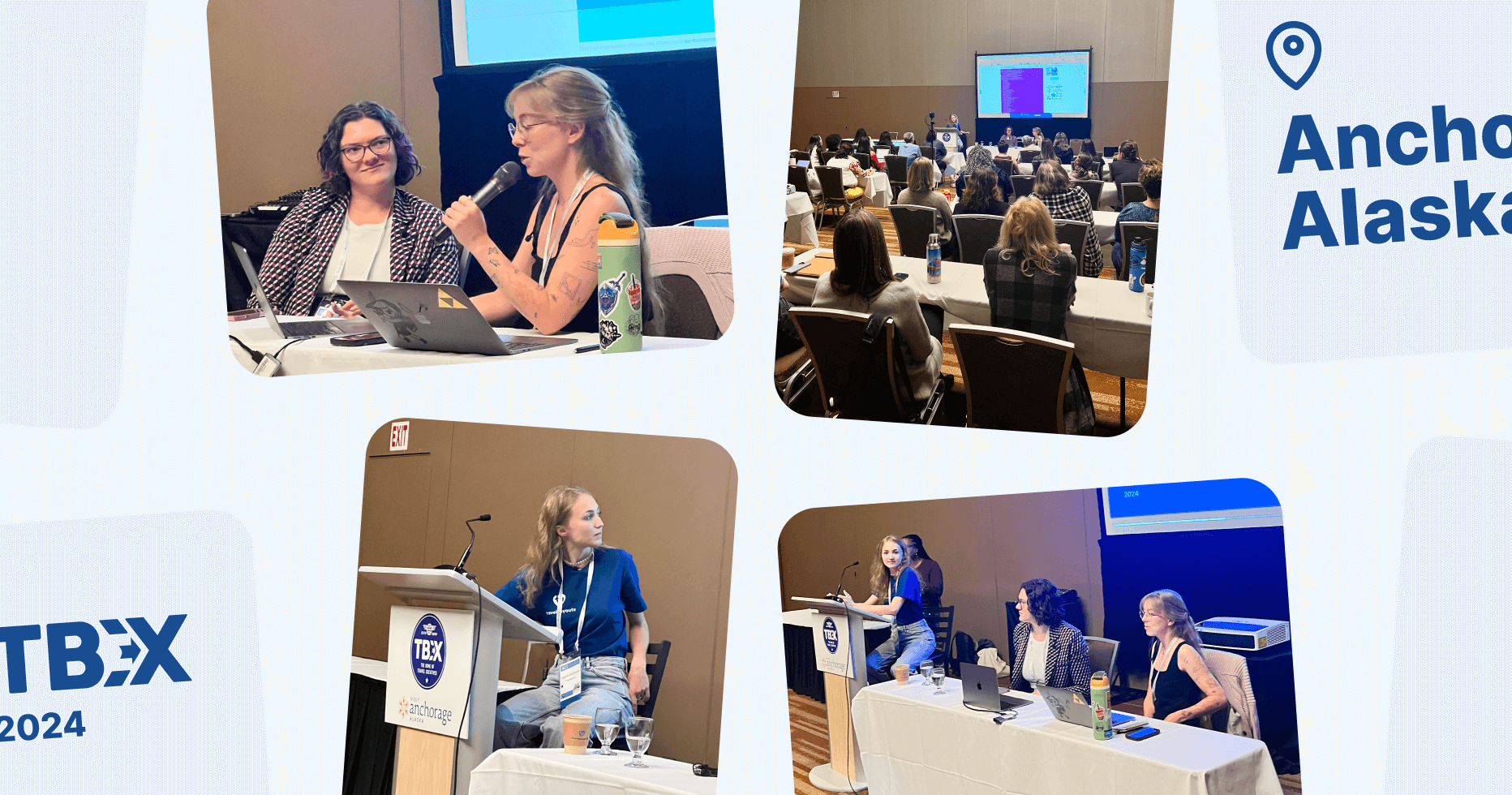At TBEX Alaska back in September 2024, SEO experts Nina Clapperton (She Knows SEO) and “Bucketlist” Bri took the stage for a hot, hot roast of audience members’ travel blogs.
We do mean roast: Nina and Bri didn’t hold back, calling out mistakes and sharing frank but valuable advice that could instantly improve your blog’s SEO and user experience.
It was exciting to witness, and we wanted to share their tips with you. From building a homepage that commands attention to crafting affiliate content that converts, here’s how you can level up your travel blog.
1. Build a strong homepage

Your homepage is the face of your travel blog. As Nina put it, the homepage should act as a billboard for your blog – it’s an introduction to who you are.
There’s also a technical reason to fine-tune your homepage: beyond first impressions, it’s typically the most authoritative page on your website because it’s the one most linked to. As Nina explained [00:04:32], search engines view it as a key source of information about your site. Ensuring it’s optimized and reflects your authority is crucial for SEO and user engagement.
So, what should be on your homepage?
- Clear introduction: A brief “About Us” or mission statement that explains who you are, your expertise, and what your blog offers.
- Featured content: Highlight your two to three best or most popular posts to highlight your value.
- Call to action: Include a visually obvious newsletter signup. As Nina emphasized [00:58:17], your CTA should include compelling reasons to subscribe, such as exclusive tips, travel stories, or special deals.
- Navigation menu: Clear organization and simple, intuitive categories help users and search engines find your content easily.
- Optimized page speed: Fast load times help with SEO and make for a better user experience. Use compressed images and lightweight design elements.
2. Streamline navigation

Navigation can make or break your blog’s usability and SEO performance. A common mistake, noted during the review of Mike’s Road Trip [00:31:36], is relying heavily on archive pages – auto-generated pages that list posts by category or tag.
Menus are another common issue, especially on mobile devices. Mike’s Road Trip had multiple menus [00:32:00], which collapsed into a confusing “hamburger menu” on smaller screens, leaving readers struggling to find content. To avoid this, simplify your menus by organizing them into clear, non-redundant categories. And always remember to test your site on mobile so you’re sure it’s easy to navigate across all devices.
Another common mistake to avoid is deep nesting, when content is buried under several subcategories, like Destinations > Europe > France > Paris > Restaurants, forcing users to click through too many levels to find content. This can be frustrating and confusing for users.
As Nina explained [00:41:02], Google favors static, curated pages over deeply nested or archive-style pages. Keeping your structure simple and intuitive helps users and search engines find your content more easily.
3. Create content hubs to showcase and organize your expertise

Content hubs, or pillars, are curated pages that group related posts under a single theme, like a destination guide for Paris that covers various aspects of the city. Hubs are a great alternative to archive pages. They generally include:
- An introductory overview to set the tone.
- Links to related posts like itineraries, activity guides, and local tips.
- A blog roll with the latest or most relevant posts on the topic.
Even if you don’t have dozens of posts on a topic, content hubs make your site easier for readers to navigate and more authoritative for search engines. Nina explained [00:41:58] that they help readers find related posts easily and make your blog more organized and user-friendly.

4. Write for your ideal audience
Knowing who you’re writing for (your “audience avatar”) helps you tailor your tone, topics, and recommendations to meet their specific needs and interests.
For example, when reviewing Lana’s affiliate post about dinner cruises in Paris [01:00:44], Nina noted that it wasn’t clear who the content was targeting. Were the cruises for couples, families, or groups of friends? This lack of clarity makes it harder to connect with readers and guide them toward the best choice.
Why your audience avatar matters:
- It helps you address specific pain points and questions your readers might have.
- You can tailor your recommendations and writing style to your ideal reader’s values.
- It creates a stronger connection and trust, making readers feel like your content is made just for them.
- It helps you maintain consistency across content.
Start by asking:
- Who is your ideal reader? (e.g., solo travelers, families, budget-conscious adventurers)
- What are their goals, challenges, or concerns?
- How can your content solve their problems or inspire them?
Keep this picture in your mind and let it guide every word you write.

5. Focus on E-E-A-T
Not sure what E-E-A-T means? Check out our article.
Nina and Bri repeatedly highlighted how many blogs contain generic content and fail to establish credibility. Articles that lack personal experience or sound like Wikipedia entries won’t connect with readers and won’t convince search engines that you’ve got Google’s quadfecta of Experience, Expertise, Authoritativeness, and Trustworthiness (E-E-A-T).
So how do you make your content stand out?
- Highlight your expertise: Explain why you’re qualified to write about the topic. Why are you the expert? Did you live there? Travel there often? Talk about it.
- Showcase your experience: Share personal stories or examples to prove you’ve “been there, done that.” Google values content created by people with firsthand knowledge.
- Demonstrate authority: Support your claims with facts, research, or references to credible sources. This gives your content more weight and shows readers they can trust your information.
- Establish trustworthiness: Be open and honest. Include affiliate disclaimers and privacy policies, and ensure your information is current.
Along with E-E-A-T, there’s also SPEAR (Search/User Intent, Pain Points, Expertise, Audience, and Rapport). This framework helps you create content that addresses your readers’ needs and solves their problems. Start your article by focusing on what your audience is looking for and the challenges they face. Show them you understand their needs and have the expertise to offer a solution.

6. Avoid thin content

Content is thin when itlacks depth, originality, or practical value for readers. In the critique of Kesito & Fro’s Packing List for Antarctica [01:14:01], Bri encouraged Kesi to make her expertise and experience shine through in her writing. It’s Antarctica, one of the most extreme and majestic places on Earth! It’s no place for stock photos and vague recommendations.
Bri said she wanted to see pictures of Kesi in Antarctica wearing the clothes she recommended, explaining what she brought and why. She pointed out that Kesi added a cute infographic about layers but instantly tried to convert readers to waterproof pants, which didn’t flow logically.

To avoid this, focus on writing articles only you can create. Share detailed stories from your trips, explain why specific items are essential, and include original photos. Readers want your perspective, not a generic list they can find elsewhere.
While SEO is important, your content should stand out by offering unique insights and connecting with your audience through your expertise. Remember: the user should always come first, followed by Google.
7. Be smart with SEO
With that said, SEO is still important. Here are some key areas where blogs often fall short.
- Choose lightweight themes: Avoid heavy themes like Elementor and Divi, which can slow down your site and hurt rankings. Instead, go for ones like Kadence, which prioritize speed and performance.
- Improve page speed: Slow-loading pages can frustrate readers and hurt rankings. Compress images, use web-friendly formats like WebP, and avoid heavy plugins or themes.
- Structure your content: Use a logical hierarchy for headings – your title should be an H1, followed by H2s, H3s, and H4s, flowing like a waterfall. Avoid overly complex structures or walls of text that can overwhelm readers.
- Avoid over-optimization: Keyword stuffing, repetitive headers, and unnecessary tags make content feel robotic. Instead, focus on the natural integration of keywords that align with user intent.
- Make navigation intuitive: Menu structures should be clear and straightforward, helping readers find content quickly. Overly complicated menus, deep nesting, or redundant categories confuse users and hurt SEO.
- Internal linking: Strategically connect related posts to guide readers deeper into your blog and signal content relationships to search engines.
Just don’t forget that humans are your most important readers. As Bri explained [00:22:54], “Even flawless SEO is just a checklist. If you compare two websites with great SEO, the only difference is the content and how you write. We need to be ourselves and tap into our experiences.” Focus on creating unique, personal content that can’t be replicated.

8. Maximize readability
Readability is just as important as having good content ideas. Visitors will likely leave if your blog is hard to read, no matter how valuable the information is. Here’s how to keep readers engaged:
- Use a table of contents: A well-organized table of contents helps readers jump to the sections they’re most interested in.
- Keep fonts readable: Use fonts at least 18–22px in size to ensure easy reading, especially on mobile devices. Tiny fonts can frustrate readers and lead to higher bounce rates.
- Write for skimming: Most readers don’t read every word – they skim for key information. People often only read the first five words of a paragraph. Use short paragraphs (two to three sentences max) and clear subheadings to guide their attention.
- Add white space: Proper spacing around text and images prevents your blog from looking cluttered and overwhelming. White space makes content more inviting and easier to navigate.
- Break up large blocks of text: Walls of text can intimidate readers and make your content harder to follow. Use clear subheadings (H2, H3, H4) to break up sections and guide readers through your post.
- Include author and date: Doing so helps readers know the content is fresh and trustworthy. This is especially important if you’re covering time-sensitive topics.
9. Use original pics, descriptive alt text, captions
As Bri pointed out, original shots are far more engaging than stock images. Take good pictures and use them – for one thing, they prove you’ve actually experienced what you’re writing about.
Captions are just as important as the images themselves, tying everything together and guiding readers through your content by connecting the visuals to your narrative. Skimmers, in particular, rely on captions to quickly understand the significance and context of an image and how it relates to the text.
Finally, alt text improves both accessibility and SEO. A picture’s alt describes it for visually impaired users and helps search engines understand your images.
Nina noted that many of the blogs she reviewed didn’t have alt text, and when it was included, it was often generic – like “road with car 4.” Instead, use specific and descriptive phrases, such as “Traveler wearing thermal gear at an Antarctic glacier,” to make your images meaningful and searchable.
10. Write affiliate content that feels personal and builds trust

Affiliate content should feel authentic, actionable, and tailored to your audience. Nina critiqued an affiliate post on Adventures by Lana about dinner cruises in Paris and highlighted several key issues that make or break trust with readers:
- Make comparisons: Simply listing options isn’t enough. Nina advised comparing experiences directly, highlighting the unique features of each and offering advice on who it’s suitable for.
- Understand your audience: The post struggled to connect because it didn’t specify who the cruises were for – couples, families, solo travelers? Without a clear audience avatar, the recommendations felt generic and unfocused, leaving readers unsure if the options matched their needs. Tailoring your content to a specific group ensures it feels relevant, personal, and actionable.
- Free sample policy: Nina likened affiliate writing to Costco’s free sample approach. Readers want a clear answer upfront, like which dinner cruise is the best, and that should be addressed in the introduction. Yes, you read that right. Spoil it right from the beginning.
- Position FAQs wisely: When people look for specific information, they don’t want to sift through FAQs at the beginning of the article. Move important, actionable details to the start and provide answers upfront.
- Craft effective CTAs: Calls to action need to appeal to different buyer types. Nina noted that Lana’s CTAs lacked variety, which limited their impact. Emotional readers may connect with storytelling, such as “Book this cruise for an unforgettable evening,” while practical readers prefer facts, like “See the best-value dinner cruise.” Budget-conscious readers might respond to “Compare prices on top-rated cruises.” Testing CTAs can reveal what works best, helping you create content that resonates with your audience.
By focusing on personal insights, clear comparisons, and reader-specific recommendations, your affiliate content can feel like genuine advice rather than a sales pitch. This will build trust and increase conversions.
Join the Travelpayouts partnership platform
Join todayTime to implement!
Optimizing your travel blog goes beyond just keywords and rankings – it’s about creating a user-friendly, authentic site packed with value. By implementing these expert-backed strategies, you can build trust with your audience, enhance your blog’s performance, and stand out in a competitive space.
So what are you waiting for? Open up your blog and start implementing these great ideas today!





